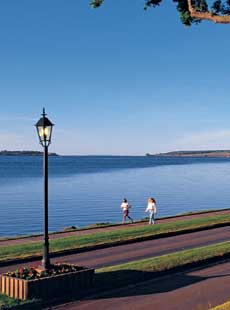Canadian cities need more green space

Recent research suggests that replacing some of your time spent in the concrete jungle with time in the real jungle (or may just a park, or waterfront greenspace) may reduce stress, anxiety and illness. Spending time outdoors has been proven to make people healthier, more productive at work and even more generous in their actions towards others. This effect has been termed “biophilia.”
At the risk of sounding superior, runners as a whole tend to spend more time outdoors than the average person. But this makes one question: is a run in the city or a run in a park or on the waterfront more relaxing? Is your run squished into the time you can make for it outside of work, or considered the most important element of your day?
 Lisa Nisbet, assistant Professor at Trent University, questions the current mindset of many Canadian city dwellers – that air conditioning, fluorescent lighting and small cubicles are the norm for five days of the week and nature is reserved for the weekends. Statistics Canada reported in 2012 that Canadians spend approximately $3.5 million travelling to the cottage, trailer park or camping ground. It would seem that residents of Canadian cities are in need of what researchers in the Netherlands have termed “Vitamin G,” as in “green” and the dose needs to come from the city itself.
Lisa Nisbet, assistant Professor at Trent University, questions the current mindset of many Canadian city dwellers – that air conditioning, fluorescent lighting and small cubicles are the norm for five days of the week and nature is reserved for the weekends. Statistics Canada reported in 2012 that Canadians spend approximately $3.5 million travelling to the cottage, trailer park or camping ground. It would seem that residents of Canadian cities are in need of what researchers in the Netherlands have termed “Vitamin G,” as in “green” and the dose needs to come from the city itself.
Ideally, the ‘weekend warriors’ would become weekday warriors.
 A study by the University of Washington showed that residential areas with more green space had lower crime rates and violent incidents. Another British study has shown that those who live near oceans or forests, on average experience a longer life span than those who reside in a downtown core. Changing an existing city is easier said than done though and urban planners are grappling with incorporating greenspace into concrete-dominated areas.
A study by the University of Washington showed that residential areas with more green space had lower crime rates and violent incidents. Another British study has shown that those who live near oceans or forests, on average experience a longer life span than those who reside in a downtown core. Changing an existing city is easier said than done though and urban planners are grappling with incorporating greenspace into concrete-dominated areas.
Professor Beatley, professor of urban and environmental planning at the University of Virginia encourages people to think of their consumption of nature like their consumption of food. An annual vacation to a beach would be a decadent dessert, a weekend at the cottage would be a meal time treat like fish and chips, but proximal, everyday nature should make up the majority of one’s ‘diet,’ just like fruits and vegetables in your real life diet.
Make the time to lace up your shoes and soak up some vitamin D and ‘vitamin G’ this summer—on vacation, at the cottage and in the city.



